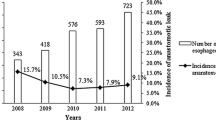Abstract
Background
An anastomotic leak after colorectal surgery is associated with significant morbidity and decreased survival. Our aim was to identify the early predictors of anastomotic leaks.
Methods
The records of patients undergoing restorative resection for colorectal disease from January 2000 to November 2005 were reviewed. Demographics, clinical events, and laboratory parameters were recorded.
Results
A total of 311 patients were included. An anastomotic leak was identified in 25 patients (8%). A leak was suspected and diagnosis confirmed at a mean of 10±1 days postoperatively. More respiratory and neurological events occurred in patients with an anastomotic leak (p<0.001). These events occurred early in the postoperative course and were usually the first signs and symptoms of a leak. More patients with a leak had absence of bowel activity by postoperative day 6 compared to patients without a leak (p<0.0001). Elevations of the white blood cell count or temperature were a late finding.
Conclusion
The earliest clinical predictors of an anastomotic leak are pulmonary and/or neurological. Awareness of these findings might help in early diagnosis and treatment of an anastomotic leak.
Similar content being viewed by others
References
Alves A, Panis Y, Trancart D et al (2002) Factors associated with clinically significant anastomotic leakage after large bowel resection: multivariate analysis of 707 patients. World J Surg 26:499–502
Koperna T (2003) Cost-effectiveness of defunctioning stomas in low anterior resection for rectal cancer. Arch Surg 138:1334–1338
Bruce J, Krukowski ZH, Al-Khairy G et al (2001) Systematic review of the definition and measurement of anastomotic leak after gastrointestinal surgery. Br J Surg 88:1157–1168
Matthiessen P, Hallbook O, Andersson M et al (2004) Risk factors for anastomotic leakage after anterior resection of the rectum. Colorectal Dis 6:462–469
Golub R, Golub RW, Cantu R Jr et al (1997) A multivariate analysis of factors contributing to leakage of intestinal anastomoses. J Am Coll Surg 184:364–372
Yeh CY, Changchien CR, Wang JY et al (2005) Pelvic drainage and other risk factors for leakage after elective anterior resection in rectal cancer patients: a prospective study of 978 patients. Ann Surg 241:9–13
Jestin P, Pahlman L, Gunnarsson U (2008) Risk factors for anastomotic leakage after rectal cancer surgery: a case-control study. Colorectal Dis 10:1–7
Sutton CD, Marshall LJ, Williams N et al (2004) Colo-rectal anastomotic leakage often masquerades as a cardiac complication. Colorectal Dis 6:21–22
Alves A, Panis Y, Pocard M et al (1999) Management of anastomotic leakage after nondiverted large bowel resection. J Am Coll Surg 189:554–559
Bruce J, Russell EM, Mollison J et al (2001) The measurement and monitoring of surgical adverse events. Health Technol Assess 5:1–194
Lipska MA, Bissett IP, Parry BR et al (2006) Anastomotic leakage after lower gastrointestinal anastomosis: men are at higher risk. A N Z J Surg 76:579–585
Walker KG, Bell SW, Richard M et al (2004) Anastomotic leakage is predictive of diminished survival after potentially curative resection for colorectal cancer. Ann Surg 240:255–259
Law WL, Choi HK, Lee YM et al (2007) Anastomotic leakage is associated with poor long-term outcome in patients after curative colorectal resection for malignancy. J Gastrointest Surg 11:8–15
Platell C, Barwood N, Dorfmann G et al (2006) The incidence of anastomotic leaks in patients undergoing colorectal surgery. Colorectal Dis 9:71–79
Hyman N, Manchester TL, Osler T et al (2007) Anastomotic leaks after intestinal anastomosis: it’s later than you think. Ann Surg 245:254–258
Khan AA, Wheeler JM, Cunningham C et al (2008) The management and outcome of anastomotic leaks in colorectal surgery. Colorectal Dis 10:587–592
Biondo S, Pares D, Kreisler E et al (2005) Anastomotic dehiscence after resection and primary anastomosis in left-sided colonic emergencies. Dis Colon Rectum 48:2272–2280
Isbister W (2001) Anastomotic leak in colorectal surgery: a single surgeon’s experience. A N Z J Surg 71:516–520
Author information
Authors and Affiliations
Corresponding author
Rights and permissions
About this article
Cite this article
Bellows, C.F., Webber, L.S., Albo, D. et al. Early predictors of anastomotic leaks after colectomy. Tech Coloproctol 13, 41–47 (2009). https://doi.org/10.1007/s10151-009-0457-7
Received:
Accepted:
Published:
Issue Date:
DOI: https://doi.org/10.1007/s10151-009-0457-7




